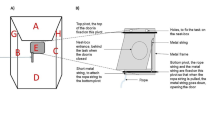Abstract
This paper deals with a specific type of traumatic avoidance for the learning process of normal dogs enclosed into a small compartment with a steel grid floor. Our aim is to analyze the behavior of the dogs in such situations and to construct a suitable mathematical model for it. The existence and uniqueness results of the proposed traumatic avoidance learning model are being investigated by the use of the Banach fixed point theorem.

Similar content being viewed by others
References
Aoki, T.: On the stability of the linear transformation in Banach spaces. J. Math. Soc. Jpn. 2, 64–66 (1950)
Banach, S.: Sur les operations dans les ensembles abstraits et leur applications aux equations integrales. Fund. Math. 3, 133–181 (1922)
Gavruta, P.: A generalization of the Hyers–Ulam–Rassias stability of approximately additive mappings. J. Math. Anal. Appl. 184, 431–436 (1994)
Hilgard, E.R., Marquis, D.G.: Conditioning and Learning, pp. 58–62. D. Appleton-Century, New York (1940)
Hyers, D.H.: On the stability of the linear functional equation. Proc. Nat. Acad. Sci. USA 27, 222–224 (1941)
Hyers, D.H., Isac, G., Rassias, ThM: Stability of Functional Equations in Several Variables. Birkhauser, Basel (1998)
Keller, F.S., Schoenfeld, W.N.: Principles of Psychology, pp. 311–315. Appleton-Century-Crofts, New York (1950)
Miller, N.E.: Learnable drives and rewards. In: Stevens, S.S. (ed.) Handbook of Experimental Psychology, pp. 435–472. Wiley, New York (1951)
Nash Jr., J.F., Rassias, T.M. (eds.): Open Problems in Mathematics. Springer, New York (2016)
Solomon, R.L., Wynne, L.C.: Traumatic avoidance learning: acquisition in normal dogs. Psychol. Monogr., 67, No. 4 (Whole No. 354) (1953)
Turab, A., Sintunavarat, W.: On analytic model for two-choice behavior of the paradise fish based on the fixed point method. J. Fixed Point Theory Appl. 21, 56 (2019). https://doi.org/10.1007/s11784-019-0694-y
Ulam, S.M.: A Collection of the Mathematical Problems. Interscience Publ, New York (1960)
Acknowledgements
The second author would like to thank the Thailand Research Fund and Office of the Higher Education Commission under Grant no. MRG6180283 for financial support during the preparation of this manuscript.
Author information
Authors and Affiliations
Contributions
All authors contributed equally and significantly in writing this paper. All authors read and approved the final manuscript.
Corresponding author
Ethics declarations
Conflict of interest
The authors declare that they have no competing interests.
Additional information
Publisher's Note
Springer Nature remains neutral with regard to jurisdictional claims in published maps and institutional affiliations.
Rights and permissions
About this article
Cite this article
Turab, A., Sintunavarat, W. On the solution of the traumatic avoidance learning model approached by the Banach fixed point theorem. J. Fixed Point Theory Appl. 22, 50 (2020). https://doi.org/10.1007/s11784-020-00788-3
Published:
DOI: https://doi.org/10.1007/s11784-020-00788-3




